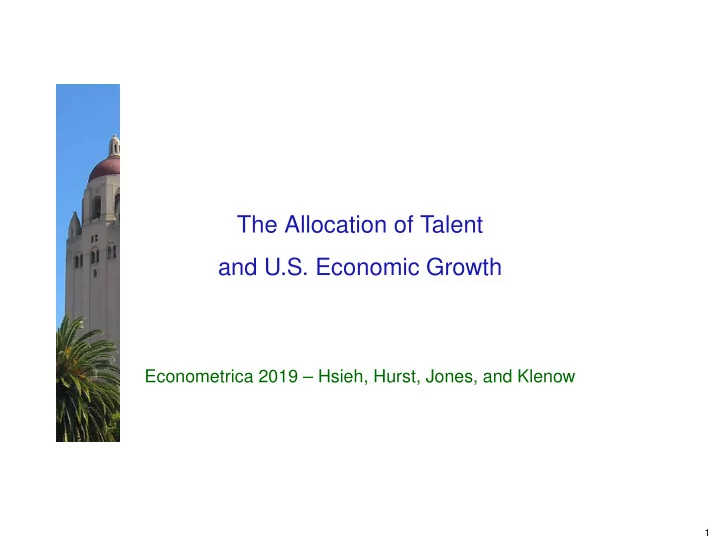

The Allocation of Talent and U.S. Economic Growth Econometrica 2019 – Hsieh, Hurst, Jones, and Klenow 1
The Allocation of Talent White Men in 1960: 94% of Doctors, 96% of Lawyers, and 86% of Managers White Men in 2010: 63% of doctors, 61% of lawyers, and 57% of managers Sandra Day O’Connor, Ruth Bader Ginsburg, David Blackwell (contraction mapping fame)... 2
Our question • Suppose distribution of talent for each occupation is identical for whites, blacks, men, and women. • Then: ◦ Misallocation of talent in both 1960 and 2010. ◦ But less misallocation in 2010 than in 1960. • Changes in occupation shares over time reveal changes in misallocation How much of productivity growth between 1960 and 2010 was due to the improved allocation of talent? 3
Share of Each Group in High Skill Occupations All groups should have the same share in high-skilled occupations (Lawyers, doctors, engineers, scientists, architects, mathematicians and managers.) 4
Framework and Data • Eaton and Kortum (2002 ECMA) applied to occupational choice ◦ Each person draws a random talent in each occupation ◦ Same distribution for all groups • People choose schooling and occupation subject to human capital and labor market “taxes” • Deviations of occupational shares from population shares reveal barriers ◦ E.g. occupations should all be 50/50 women/men • Data from Decennial Census and American Community Survey (IPUMS) 5
Wage Gaps and Relative Propensities (Women in 1980) 64x more likely to be Secretary OCCUPATIONAL WAGE GAP (LOGS) 4x less likely to be Lawyer 0.7 but same wage gap! FarmMgrs 0.6 Food Sales PersonalService 0.5 Doctors OtherVehicle Prod.Inspectors PrivateHshld FoodPrep MotorVehicle Misc.Repairer Info.Clerks Managers Textiles 0.4 FinancialClerk MetalWork ComputerTech Cleaning Construction Misc.Admin MgmtRelated WoodMach. WoodWork Insurance HealthService 0.3 Eng.Techs Clerks OfficeMachine Secretaries Nurses Lawyers Records Extractive Soc.Scientists Mail Architects HealthTechs Arts/Athletes Engineers Guards Teachers Firefighting 0.2 Professors Police Math/CompSci Mechanics Therapists Science Elec.Repairer PlantOperator 0.1 Librarians SocialWork 0 1/64 1/16 1/4 1 4 16 64 RELATIVE PROPENSITY, P(WW)/P(WM) 6
How to understand the preceding graph... • Basic model: wage gaps and relative propensities are uncorrelated • The key is selection ◦ Women lawyers face large barriers ⇒ only the best become lawyers ◦ Women are encouraged to be secretaries, so many do, including those who are less talented ◦ With a Fr´ echet distribution of talent, these selection effects precisely offset the direct “tax” effect... ◦ ... so wage gaps and propensities should be uncorrelated • Basic model ◦ Wage gaps: depend on average of barriers across all occupations ◦ Relative propensities: depend on the barriers in each occupation 7
Female Wages Gaps Relative to White Men by Time and Cohort LOG WAGE GAP -0.15 Mostly cohort effects instead of time effects ⇒ human capital frictions? -0.2 -0.25 -0.3 -0.35 -0.4 -0.45 -0.5 -0.55 -0.6 1960 1970 1980 1990 2000 2010 8
Economic Growth and the Allocation of Talent GDP PER PERSON (1960=100) 240 220 Overall 40% of growth in GDP 200 per person from declining barriers 180 160 h and w at 1960 levels 140 120 100 1960 1970 1980 1990 2000 2010 YEAR 9
How much did growth benefit from declining barriers? —— annual rates —— Actual Growth with Growth 1960 barriers Difference Share GDP per person 1.7% 1.0% +0.7% 41% GDP per worker 1.2% 0.9% +0.3% 24% LF Participation 0.4% 0.0% +0.4% 90% Earnings of WM 0.9% 1.0% -0.1% -12% Earnings of WW 3.2% 0.7% +2.5% 77% Earnings of BM 2.2% 1.6% +0.6% 29% Earnings of BW 4.3% 2.1% +2.2% 51% 10
How much did growth benefit from declining barriers? —— annual rates —— Actual Growth with Growth 1960 barriers Difference Share GDP per person 1.7% 1.0% +0.7% 41% GDP per worker 1.2% 0.9% +0.3% 24% LF Participation 0.4% 0.0% +0.4% 90% Earnings of WM 0.9% 1.0% -0.1% -12% Earnings of WW 3.2% 0.7% +2.5% 77% Earnings of BM 2.2% 1.6% +0.6% 29% Earnings of BW 4.3% 2.1% +2.2% 51% 11
How much did growth benefit from declining barriers? —— annual rates —— Actual Growth with Growth 1960 barriers Difference Share GDP per person 1.7% 1.0% +0.7% 41% GDP per worker 1.2% 0.9% +0.3% 24% LF Participation 0.4% 0.0% +0.4% 90% Earnings of WM 0.9% 1.0% -0.1% -12% Earnings of WW 3.2% 0.7% +2.5% 77% Earnings of BM 2.2% 1.6% +0.6% 29% Earnings of BW 4.3% 2.1% +2.2% 51% Moving to zero barriers would raise GDP by an additional 10 percent. 11
Conclusion • The U.S. does not have a perfect allocation of resources • A surprisingly large amount of growth between 1960 and 2010 results from declining barriers and the improved allocation of talent ◦ 40% of growth in GDP per person ◦ 24% of growth in GDP per worker • This same idea can be applied in many contexts ◦ The allocation of talent within other countries ◦ The allocation of talent across countries [link to the paper] 12
Recommend
More recommend